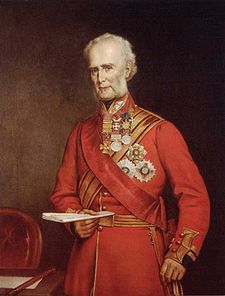
Baron Seaton
Encyclopedia

Peerage of the United Kingdom
The Peerage of the United Kingdom comprises most peerages created in the United Kingdom of Great Britain and Ireland after the Act of Union in 1801, when it replaced the Peerage of Great Britain...
. It was created on 14 December 1839 for the soldier and colonial administrator Sir John Colborne
John Colborne, 1st Baron Seaton
Field Marshal John Colborne, 1st Baron Seaton, GCB, GCMG, GCH, PC was a British field marshal and colonial governor.-Early service:...
. He fought at the Battle of Waterloo
Battle of Waterloo
The Battle of Waterloo was fought on Sunday 18 June 1815 near Waterloo in present-day Belgium, then part of the United Kingdom of the Netherlands...
and was Lieutenant Governor of Upper Canada from 1828 to 1836, acting Governor General of British North America from 1837 to 1838 and Commander-in-Chief of North America
Commander-in-Chief, North America
The office of Commander-in-Chief, North America was a military position of the British Army. Established in 1755 in the early years of the Seven Years' War, holders of the post were generally responsible for land-based military personnel and activities in and around those parts of North America...
from 1838 to 1839. He later served as Commander-in-Chief of Ireland
Commander-in-Chief, Ireland
Commander-in-Chief, Ireland was title of the commander of British forces in Ireland before 1922.The role nominally is held by the President of Ireland today as the supreme commander of the Defence Forces.-Commanders-in-Chief, Ireland, 1700-1922:...
between 1855 and 1860 and was promoted to Field Marshal
Field Marshal
Field Marshal is a military rank. Traditionally, it is the highest military rank in an army.-Etymology:The origin of the rank of field marshal dates to the early Middle Ages, originally meaning the keeper of the king's horses , from the time of the early Frankish kings.-Usage and hierarchical...
in 1860. Lord Seaton was succeeded by his eldest son, the second Baron. He was Military Secretary to his father when Commander-in-Chief of the Forces in Ireland.
On his death the titles passed to his eldest son, the third Baron. He was a Major in the Royal 1st Devon Yeomanry and fought in the Second Boer War
Second Boer War
The Second Boer War was fought from 11 October 1899 until 31 May 1902 between the British Empire and the Afrikaans-speaking Dutch settlers of two independent Boer republics, the South African Republic and the Orange Free State...
and in the First World War. Lord Seaton married Elizabeth Beatrice (d. 1937), daughter of Sir Francis Fuller-Eliott-Drake, 2nd Baronet, of Nutwell Court and Buckland Abbey
Buckland Abbey
Buckland Abbey is a 700-year-old house in Buckland Monachorum, near Yelverton, Devon, England, noted for its connection with Sir Francis Drake and presently in the ownership of the National Trust.-History:...
(a title which became extinct on his death in 1916), in 1887. In 1917 he assumed by Royal Licence the additional surnames of Eliott-Drake. Lord Seaton was childless and on his death in 1933 the title passed to his younger brother, the fourth Baron. He was a Major in the South Staffordshire Regiment
South Staffordshire Regiment
The South Staffordshire Regiment was an infantry regiment of the British Army formed in 1881 by the amalgamation of the 38th Regiment of Foot and the 80th Regiment of Foot. In 1959 the regiment was amlagamated with the North Staffordshire Regiment to form the Staffordshire Regiment...
and served in the Nile Expedition of 1884 to 1885, where he was severely wounded, in the Second Boer War and in the First World War. Lord Seaton married Caroline Mabel, daughter of Sir Arthur Pendarves Vivian
Arthur Vivian
Sir Arthur Pendarves Vivian KCB was a British industrialist, mine-owner and Liberal politician, who worked in south Wales and Cornwall, and sat in the House of Commons from 1868 to 1885.-Early life and education:...
, in 1904. In 1927 he assumed by Royal license the additional surname of Vivian. He was also childless and on his death in 1955 the barony became extinct.
Another member of the Colborne family to gain distinction was the Hon. Sir Francis Colborne
Francis Colborne
General Sir Francis Colborne KCB was Commander of British Troops in China, Hong Kong and the Straits Settlements.-Military career:...
(1817–1895), second son of the first Baron. He was a General in the Army.
Barons Seaton (1839)
- John Colborne, 1st Baron SeatonJohn Colborne, 1st Baron SeatonField Marshal John Colborne, 1st Baron Seaton, GCB, GCMG, GCH, PC was a British field marshal and colonial governor.-Early service:...
(1778–1863) - James Colborne, 2nd Baron Seaton (1816–1888)
- John Eliott-Drake-Colborne, 3rd Baron Seaton (1854–1933)
- James Colborne-Vivian, 4th Baron Seaton (1863–1955)

